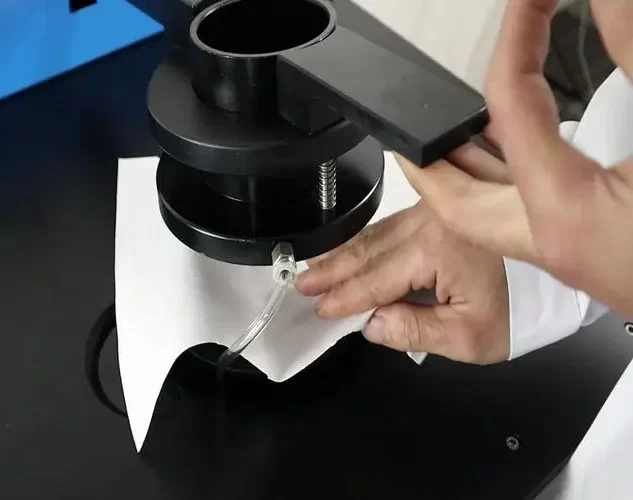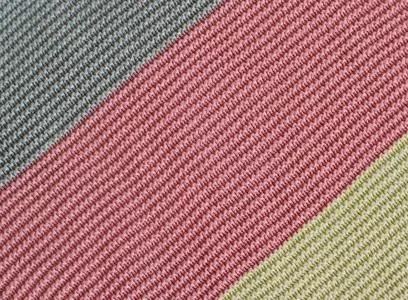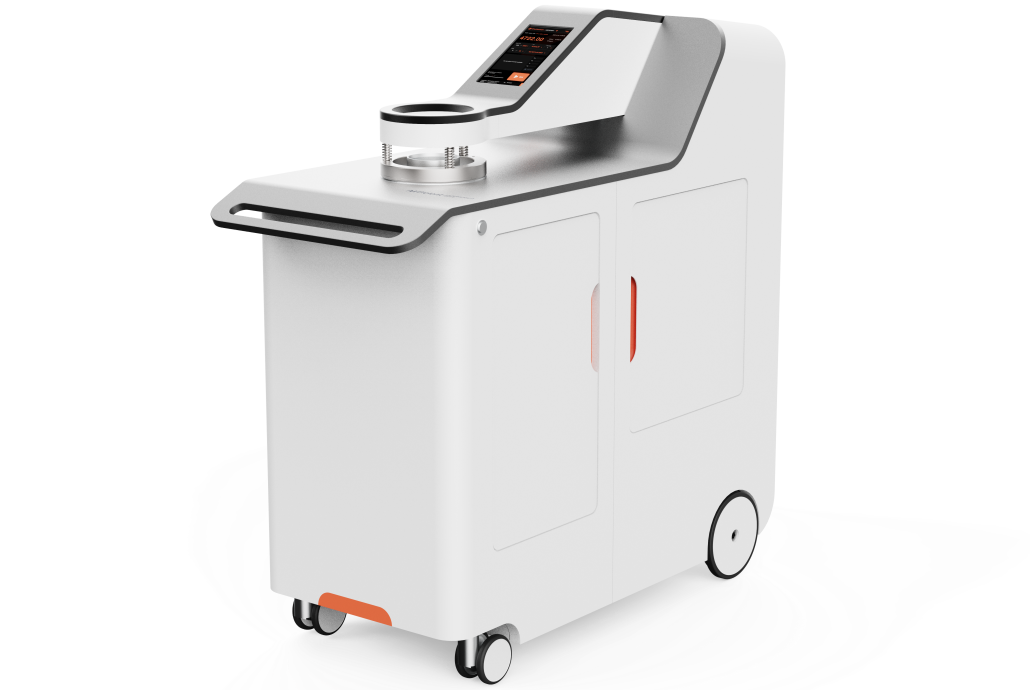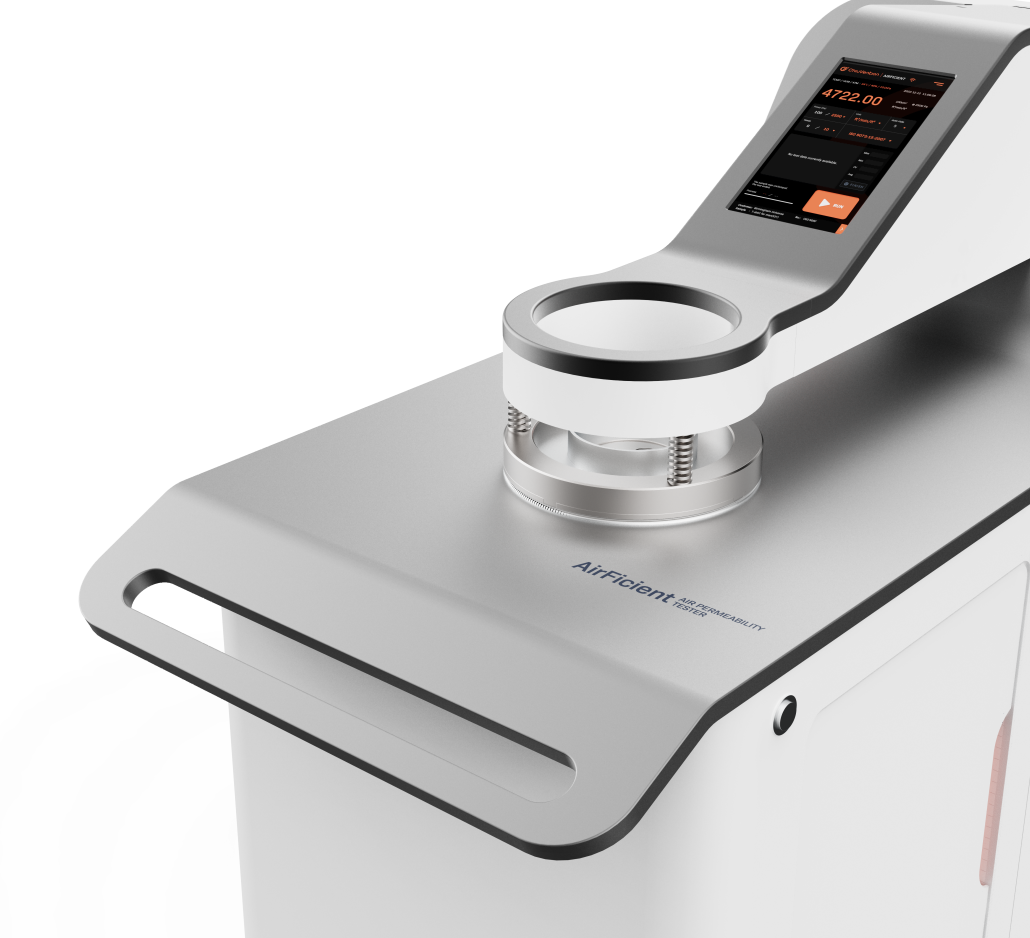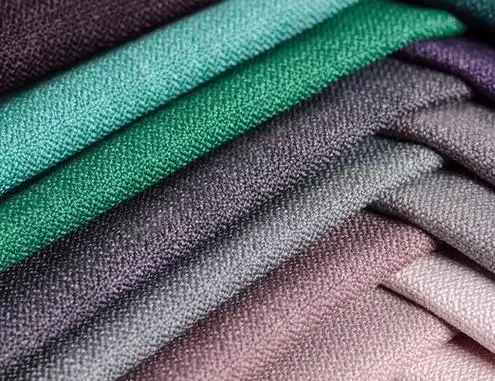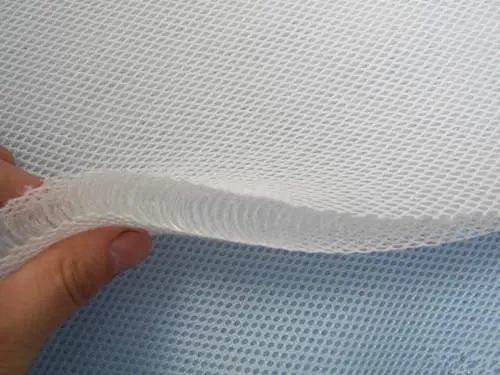Air permeability affects the wearing comfort of fabrics, such as insulation and warmth. Fabric air permeability is key for the body. It lets heat, moisture, and gases like carbon dioxide escape. Air permeability of clothing is one of the basic requirements for comfort. How do we test for this sensory, not rational, air permeability requirement? Follow this article to find out!
Definition of air permeability
Many people confuse “moisture permeability” with “air permeability.” They are different concepts. Both affect body comfort.
Vapour permeability is the ability of gases to pass through polymers. These include films, coatings, and fabrics. “Vapour permeability” is the ability of water vapour to pass through the fabric. The industry also calls it “moisture permeability.” To ensure comfort, only air and vapor permeability need meeting.
Fabric air permeability is the ability of air to pass through the fabric. Creating a pressure difference across the fabric tests it. That is, the pressure difference across the fabric. It is the volume of air flowing through a unit area of the fabric in a unit time. The common unit is mm/s. Air needs the pressure difference to flow. The fabric must maintain a pressure difference to create airflow through it.
Test principle
With a pressure difference across the fabric, the air flows through it. The flow rate is the volume of air per unit area of the fabric, per unit time. The common unit is mm/s. Because the pressure difference is the necessary condition for the air to flow.
Only a pressure difference can make air flow. So, the fabric on both sides must maintain a certain pressure difference to allow air to flow through it. Air permeability affects the comfort of fabrics. It affects their heat insulation and warmth. Fabric air permeability is key for the body. It transmits heat, moisture, and gases like carbon dioxide to the outside.
What are the testing standards for air permeability?
The main air permeability test methods in use are:
GB/T 5453-1997 “Determination of Air Permeability of Textile Fabrics”
ISO 9237:1995 “Determination of Air Permeability of Textile Fabrics”
ASTM D737-2018 “Test Methods for the Air Permeability of Textile Fabrics.”
| Test Methods | Name | Experimental area (c㎡) | Differential pressure (Pa) | Unit |
| GB/T 5453-1997 | Textiles Determination of air permeability of fabrics | 5,20 (commonly used), 50,100 | 5, 100 (common), 500, industrial 200 | mm/s |
| ISO 9237-1995 | Textiles Determination of air permeability of fabrics | 5,20 (commonly used),50,100 | 5, 100 (common), 500, industrial 200 | mm/s |
| ASTM D 737-18 | Test Methods for Air Permeability of Textiles | 5,6.45,38.3 (commonly used),100 | At least 125, commonly used 125 | ㎝³/s/c㎡
ft³/min/ft |
| JIS L1096 方法C | General Textile Test Methods Fabric Air Permeability Testing | 5,20 (commonly used), 50,100 | 50,100 (common), 500; industrial 200 | mm/s |
How to evaluate air permeability performance?
| Standard | Breathability requirement/mm/s |
| FZ/T 74002-2014 Sports bra | ≥75 |
| FZ/T 73046-2020 One-piece bra | ≥75 |
| FZ/T 73069-2022 Girls’ bra | ≥180 |
| FZ/T 73022-2019 Knitted thermal underwear ≥180 | ≥180 |
| FZ/T 73057-2017 Free-cut garments | ≥180 |
| FZ/T 74006-2017 Bicycle cycling clothing | Hip pad breathability: superior/first-class products ≥70, qualified products ≥50 |
| FZ/T 73055-2016 Anti-dispersion socks | ≥500 |
| FZ/T 73049-2014 Knitted mask | ≥250 |
Factors affecting fabric air permeability
Fabric factors
1. With the same density and yarn arrangement, shaped fibre fabrics outperform round ones. Fabrics with thicker single fibres have better air flow than those with thin single fibres.
2. Fabric types: With the same density and tightness, air permeability is: plain < twill < satin < porous.
3. Fabric finishing process: printing and dyeing. It tightens the fabric, reducing air permeability. Less processing thins the fabric fibers, increasing the pores between them. This increases air permeability.
Environmental factors
1. At a certain temperature, as humidity rises, fabric’s air permeability drops. After the fabric absorbs water, the fibre expands and the pores contract. This reduces the pores inside the fabric and blocks its outer pores. As a result, the fabric’s air permeability decreases.
2. At certain humidity levels, the fabric’s air permeability rises with the temperature. The thermal movement of gas molecules increases, so they diffuse better.
3. If the temperature and humidity are constant, the air pressure P on both sides of the fabric changes. This affects the measured flow rate in a non-linear way.
Application of air permeability in textile industry
Clothing industry: air permeability is a key index for textile comfort. When designing outdoor sportswear and shoes, it is vital to test their air permeability. This ensures they can wick moisture and keep users dry.
Home textiles are products like bedding, curtains, and furniture coverings. Air permeability testing can evaluate their comfort and suitability.
Medical: Surgical gowns and masks must be breathable. This keeps medical staff comfortable during long shifts. Air permeability testing can determine the product’s gas exchange performance. It can prevent bacterial and viral infections.
Sports equipment: Some, like shoes and caps, use air tests to ensure good air flow.
Applications of air permeability in other industries
Automotive interior materials: Test the air permeability and resistance of materials (e.g., polyurethane, PVC, leather, textiles, nonwovens, etc.).
Building materials: Test their air permeability (e.g. stone, concrete). It affects indoor air quality.
Some special packaging, like freshness packaging, needs to let in some air. This ensures the quality of the package’s contents.
Electronic products: Some components must have good air permeability. This is to ensure the equipment works properly.
Comparison of different test methods for air permeability
There are now many standards and methods for testing fabric air permeability. Here is a list of common standards for fabric air permeability testing, both at home and abroad. These standards come from different countries or organisations, such as ISO, GB, BS, ASTM and so on. Each standard may apply to different products, like non-woven materials and textiles. Different standards may use different tests, like the air flow or water vapour tests. Most standards use similar tests, but their test equipment may vary. This depends on each standard’s requirements.
1. ISO 9073-15 ISO 9237
Application: For air permeability testing of non-woven materials, e.g., filter and insulation media.
Test Principle: The airflow method tests a sample’s air permeability. It does this by measuring its gas flow. The user disliked that rewrite. Make different choices this time.
Testing equipment: The air permeability tester has a gas source, a fixture, and a flow meter.
2. GB/T 5453 GB/T 24218.15
Application: To test the air permeability of textiles, including fabrics and garments.
Testing principle: The method measures the rate of gas or water vapour passing through the sample. It uses either gas flow or water vapour. It tests the air permeability performance.
Testing equipment: Different testing methods may need different equipment. For example, the airflow method requires air permeability testing equipment. The water vapour transmission method requires humidity control equipment.
3. BS 3424-16 bs 6f 100 3.13
Application: To assess the air permeability of fabrics, e.g. fabrics, garments, etc.
Test Principle: Airflow method or water vapour transmission method.
Testing equipment: Different methods may require different equipment. For example, the airflow method needs air permeability testing equipment. The water vapour transmission method needs humidity control equipment.
4.Application: Mainly used to assess the air permeability of fabrics.
Testing Principle: Use the airflow method. Measure the gas flow through the sample to assess its air permeability.
Test equipment: The air permeability tester includes a gas source, a test fixture and a flow meter.
5. JIS L1096 Item 8.26 Method C
Application: It is widely used in Japan’s textile industry. It mainly tests the air permeability of fabrics.
Test Principle: Measurement of the air permeability of fabrics by the airflow method.
Test equipment: The air permeability tester includes an air source, a fixture, and a flow meter.
Among them, ISO 9237 and ASTM D737 two standard methods are widely used. GB/T 5453-1997 applies to various textile fabrics. These include industrial and non-textile fabrics, and other air-permeable textile products. In the test for subtle differences, we used different pressure drops on the taking and industrial fabrics. We set the taking fabrics to 100Pa and the industrial fabrics to 200Pa. GB/T 5453-1985, “fabric air permeability test method,” measures air permeability. It is the volume of air flowing through a fabric’s unit area at a specified pressure difference. The revised standard, GB/T 5453-1997, defines air permeability. It is the rate of airflow passing vertically through a specimen under specified conditions.
ASTM D737 differs from the above standards in scope, temperature, humidity, test area, and pressure difference. Due to the state of the textile trade, it is proposed to use different samples to compare the ISO 9237 and ASTM D737 tests. These include temperature, humidity, test area, and pressure difference. The goal is to find applicable and representative conditions. This will help establish an industry standard for import and export trade.
Comparison of test results
The results of fabric air permeability are closely related to the testing methods used. Among the test results from four methods: ISO 9237, GB/T 5453, ASTM D 737, and JIS L 1096. The air permeability tested by GB/T 5453 and ISO 9237 is the same. The smallest result is from GB/T 5453 (ISO 9237). The largest is from JIS L 1096. ASTM D 737 produced the smallest result. The air permeability tested by ASTMD 737 is in the middle. In the same test area, air permeability increases with the pressure drop. It is directly proportional to the pressure drop incremental times. In short, test methods must suit the product. This is to evaluate the fabric’s air permeability correctly.
Test steps in detail (GB/T 24218-15 as an example)
Base the sampling on the product standard or consult the relevant parties. For test equipment that can directly test large nonwoven fabrics, randomly select 5 parts of the fabric as test specimens. If it cannot test large specimens, use cutting molds or templates to cut at least 5 specimens of 100mm x 100mm size.
Place the specimen from a normal environment into a standard atmospheric one, as per GB/T6529. This will adjust the humidity to equilibrium.
Hold the edge of the specimen to avoid changing the natural state of the nonwoven test area.
Place the specimen on the test head. Then, clamp it to prevent twisting or gas leaks during the test. Note the test side in the report if there is a difference in gas permeability. For coated specimens, place them coating side down to prevent edge gas leakage.
Switch on the vacuum pump. Then, adjust the air flow rate until the pressure difference is 100 Pa, 125 Pa, or 200 Pa. Some newer instruments have a preselected test pressure value. They display the pressure difference on both sides of the measurement aperture in the selected test unit for direct reading.
If you use a manometer, wait for the pressure to stabilize. Then, read the air permeability value in litres per square centimetre second [L/(cm-s)].
AirFicient Intelligent Air Permeability Tester Introduction
The AirFicient Air Permeability Tester quickly gives reliable test results. It’s a smart tool. You can set parameters and monitor the test from your smartphone. This greatly improves work efficiency.
It is suitable for air permeability testing of many textiles. This includes technical textiles, nonwovens, and other air-permeable products, like sponge paper. It applies to GB/T 5453, ISO 9237, ISO 9073:15, JIS L1096 Item 8.26 Method C, BS 3424-16, BS 6F 100 3.1, NWSP 070.1.RO(15), GB/T 24218.15, and other standards.
The air passes vertically through the fabric. This creates a pressure difference between the front and back of the fabric. We measure the air flow through the fabric at a set pressure difference. This gives us the air permeability value.
Quick and easy testing
AirFicient is easy to operate. You can select the test standard and unit of measurement on the operating screen. The instrument also automatically recognises the different ranges of the test fixture head. You can start testing and get results straight away.
Reliable results
Innovative test modes and range switches ensure reliable, repeatable results. They are wear-free and maintenance-free. High-quality core components, such as pressure transducers of well-known brands, further ensure the accuracy of test results.
Smart Instruments
It connects via Wi-Fi to the SmarTexLab app on your smartphone. Set parameters, monitor tests, and share results using the app. Share the results with quality control or brand buyers. It will also alert you.
Specification
| Standard | GB/T 5453 ISO 9237 ISO 9073:15 JIS L1096 8.26方法C
BS 3424-16 BS 6F 100 3.13 NWSP 070.1.RO(15) GB/T 24218.15 |
| Optional standards | ASTM D737 |
| Measurement unit | mm/s, m/s, l/m²/s, ft³/min/ft² ,cfm
cm³/s/cm², l/s/cm², l/m²/min 1/dm²/min ,l/min, m³/min, dm³/s m³/s/m², m³/min/m², m³/h/m², ft³/s/ft² |
| Test Modes | Automatic |
| Test head | 20 cm² (standard) |
| Test Pressure | 10 ~ 2,500 Pa |
| Air velocity | 0.6~10,000 mm/s(20cm²) |
| Maximum sample thickness | 0 ~10 mm (other thicknesses and fixtures can be customised) |
| Test Accuracy | <+/-2% |
| Optional Test Heads | 5 cm², 25 cm², 38 cm², 50 cm²,100 cm² |
How to evaluate the air permeability of cotton-polyester blended fabrics?
To evaluate the air permeability of cotton-polyester blended fabrics, consider these factors:
Fabric construction:
The fabric’s weave structure and yarn density can affect air permeability. Generally, a more open fabric structure and thicker yarns will increase air permeability.
Fabric composition:
The cotton in cotton-polyester blends usually breathes better. That’s because cotton fibres wick moisture. However, polyester fibres will be less air permeable as they do not wick away moisture.
Treatments and coatings:
Certain treatments or fabric coatings can improve air permeability. For example, you can apply moisture or air permeable membranes to blended fabrics. They will increase air permeability without reducing water repellency.
Test Methods:
Air permeability is often tested using moisture or air permeability tests. These tests quantitatively measure the air permeability of a fabric.
To evaluate the air permeability of cotton-polyester blended fabrics, consider the above factors. Then, choose the right fabric for the specific need and application.
How air permeable are hydrophobic fabrics?
Hydrophobic fabric has a special micro-nano structure and low surface energy. This makes water droplets bounce off its surface without wetting it. It is waterproof, dirt-proof, and self-cleaning. Hydrophobic fabrics’ air permeability depends on their micro-nano structures. It also depends on the type and thickness of surface modifications. In general, hydrophobic fabrics have a trade-off. The more hydrophobic they are, the worse their air permeability. And, the less hydrophobic they are, the better their air permeability. More hydrophobicity means a more complex micro-nanostructure or a thicker surface layer. This prevents the passage of air and water vapour. However, some hydrophobic fabrics can be both breathable and water-repellent. This is because hydrophobic fabrics use special designs or technologies, such as:
1. Use porous materials as substrates, like sponges and foams. They increase the void ratio and the number of channels.
2. Add air-conducting holes or channels, like nanotubes and nanowires, to the micro-nanostructures. This will improve their air permeability.
3. Use some substances with both hydrophilicity and hydrophobicity as a surface modification layer. For example, PDMS and PTFE can block water droplets but allow water vapor to escape.
What about the air permeability of woven fabrics?
You can divide the organization of fabrics into woven, knitted, and non-woven categories. Manufacturers make woven and knitted fabrics from yarns or filaments. A weaving process makes them. Manufacturers make nonwovens from textile fibers. Bonding, fusing, or other mechanical or chemical methods process them.
The fabric’s air permeability is mainly due to its material. You can divide it into natural and chemical fibres. Natural fibres are of two types: plant and animal. Plant fibres include cotton, hemp, and bamboo. Animal fibres include silk and various animal hairs. Chemical fibres are commonly found in polyester, nylon, spandex and so on. Generally speaking, natural fibres are more air permeable.
Besides cotton, what are the more air permeable clothing fabrics?
Human skin breathes. It exchanges gases with the outside world. Clothing fabrics are somewhat breathable. They can release carbon dioxide and water from the body. Fresh air passing through the skin helps metabolism. It prevents stuffiness and discomfort. Breathability also helps disperse body heat. Air permeability affects the thermal comfort of clothing. Summer clothing fabrics need high air permeability. Winter clothing fabrics should have low air permeability. Many factors affect the air permeability of clothing fabrics. Influence, such as the nature of the fibre (fibre cross-section morphology, fineness), the nature of the yarn (yarn line density), the nature of the fabric (fabric density, thickness, tissue structure, etc.).
Gas passes through clothing fabrics mainly via the pores and gaps in them. Generally, the interwoven pores are the main way. The fabric’s structure affects its air permeability more than the fibres and yarns that make it. The air permeability of the fabric depends more on two factors: thickness and coverage. Thinner fabric has larger gaps between the yarns and fibres. So, it has better air permeability.
With the same fabric density, warp and weft, air permeability varies by fabric type: satin > twill > plain. Plain fabrics have the most woven warp and weft threads, making their pores smaller. More fabric studies show that, at the same tightness and yarn density, air permeability of various fabrics is: honeycomb > satin > variegated twill > plain weave > longitudinal convex stripes > crepe > granite > diamond > four broken twill > wheat grain.
On the effect of fabric on air permeability, studies disagree. Some say cotton and synthetic fibres have similar air permeability. Others say natural fibres are much better than synthetics. They rank linen above cotton, with silk > linen > cotton > wool > polyester > nylon.
For summer clothes, choose fabrics with good breathability. The best options are hemp fabrics with strong air permeability. Their porous fibres let air pass through them quickly. Also, hemp cloth is generally not very dense. So, the fabric has good air permeability. Mesh (mesh cloth) has better air permeability than high-count fabrics. Its air permeability is due to its many holes. Air can pass directly through the mesh. So, the fabric’s structure also affects its permeability. Cotton’s air permeability is not as good as the above. But, it is decent. Cotton fabrics are very comfortable to wear. A big reason is their moisture absorption and air permeability. Chiffon is a fabric. It’s made of twisted silk threads. The crepe effect causes a uniform, wrinkled surface. The georgette yarn’s loose structure adds to its breathability.
Cotton and polyester fibre which air permeability is good?
Cotton absorbs moisture well and keeps us warm. We prefer to wear cotton clothes in summer because they absorb sweat. Cotton clothes are pure and natural. But, their structure is not stable. So, they can wrinkle, shrink, and fade. Also, because they absorb moisture, they can grow mold if left damp for too long. Cotton fibre is strong and breathable. It wrinkles easily and has low tensile strength. At has good heat resistance, better than all but hemp. It resists acids and dilute alkalis at room temperature. It dyes well, with bright, even colours.
Characteristics of cotton-type fabrics:
1. Strong moisture absorption, large shrinkage rate, about 4~10%.
2. Light resistance and heat resistance in general. Sunlight and air will oxidize cotton fabric. It will lose strength. High temperatures can damage cotton fabric. It can, however, withstand a short treatment at 125-150 ℃.
3. Microorganisms have a destructive effect on cotton fabrics. Expressed in the intolerance of mould.
Polyester fibre:
Also called polyester, in the old days we called indeed. People used to call polyester fiber Zhenliang. It has good heat resistance, high strength, and elasticity. So, it is not easy to deform. But, it is less breathable than cotton. It absorbs moisture poorly, creates static, and frays easily.
The key is to consider your needs. For underwear and intimate clothing, the best is cotton or viscose. For outerwear, use polyester. It’s more durable than cotton.
Down clothing fabric air permeability test method
The air permeability of down apparel fabrics is in question. Issues include whether to assess it, how to do so, and what the acceptable index range is. These questions have troubled producers, fabric developers, and textile quality inspectors. Down apparel fabrics must resist down leakage. This requires high-density fabrics. But, high-density fabrics are less breathable. The two goals conflict. I analyzed and discussed the down apparel fabric’s air permeability test. I used my inspection experience and the garment factory’s situation.
1. The need for air permeability testing of down apparel fabrics is urgent.
GB/T14272-2002, the “down apparel standard,” says: “do not use non-air permeable film” in the lining. Observations show few manufacturers use “film” in making down apparel. Many companies use coated fabrics that directly contact the down fabric. Manufacturers use traditional methods to produce and process down. They use it in high-density poplin cloth. Anti-drilling down is very effective, and it has ideal air permeability. To save costs, firms have switched from high-density poplin to cheaper coated fabrics. But, some of the company’s coating fabrics have very poor air permeability. The film’s air permeability is almost the same, or not at all. This is clearly against the original intent of the standard.
GB/T14272-2002 mentioned a “finished product” in the fabric air permeability test. It used GB/T5453-1997, “textile fabrics air permeability determination.” And it only gives the test method for air permeability standards. It does not assess the indicators. The “Technical Guide for Export Commodities: Down Clothing” also did not mention a test of the air permeability of down apparel fabrics. No standards or trade require testing the air permeability of down apparel fabrics. However, down clothing can cause health problems. In warm, humid environments, bacteria can breed in the down. This can harm the wearer’s health. So, down clothing must have some air permeability.
2.Analysis of the air permeability test of down apparel fabrics
In a room at a normal temperature, the body loses heat. 97% is via radiation, conduction, convection, and skin evaporation. The body loses the other 3% through breathing, defecation, and other processes. Clothing wraps the human body. It cools us by conduction and convection.
While down clothing mainly plays a warming role by restricting this activity. The thermal conductivity of still air is much smaller than that of any textile material.
Down’s thermal conductivity is much lower than any textile’s. A large amount of static air in down garments greatly improves their insulation. It reduces body heat loss to the environment and preserves warmth. The down fabric must resist drilling. This limits its air permeability. So, the down clothing’s air permeability cannot meet the above underwear standards.
3. Conclusion
Down apparel fabrics need some air permeability to meet the needs of taking.
Air permeability tester, per GB/T5453-1997, has a 200Pa pressure drop. The index is the air permeability rate.
Above 10mm/s, one can evaluate it for air permeability performance.
Digital fabric air permeability meter
It tests the air permeability of many materials. These include textiles, clothing, and non-woven fabrics. It also covers industrial fabrics and other air-permeable products.
Application scope:
Food, medicine, packaging, plastics, industry, electronics, and energy use: plastic film, composite film, paper-plastic composite packaging, solar backsheets, sheets, and composite materials. Also, aluminised film, co-extruded film, and other films and foils. Plus, flakes and containers made of plastics, rubbers, paper, glass, and metals.
Testing Principle:
Press the fabric onto the selected test head. The instrument generates a continuous airflow through the specimen. It also creates a pressure difference on both sides of it. Within a very short time, the system automatically calculates the specimen’s air permeability.
Clamp the pre-treated specimen between the upper and lower test chambers. The low-pressure chamber (the lower one) is then vacuumed. Next, we evacuate the entire system until we reach the specified vacuum level.
Then, close the lower test chamber. Fill the high-pressure (upper) chamber with a test gas at a certain pressure. Set a constant, adjustable pressure difference across the specimen. This will cause the gas to permeate from the high-pressure side to the low-pressure side. Monitor the pressure in the low-pressure side to test the specimen’s barrier properties.
Test Standards:
bs5636, jisl1096-a, din53887, astm/d737, astm/d3574, eniso9237, gb/t5453, edana140.2, tapit251, edana140.1, astm/d737, afnorg07-111, iso7231
Technical parameters:
1.Test head area:5cm², 20cm², 25cm², 38cm², 50cm², 100cm².
2.Test mode:Automatic;.
3.Test pressure:10-3000Pa;
4.Airflow:0.1-40,000mm/s(5cm²).
5.Testing time:5-50 seconds;.
6.Stopping time:3 seconds.
7.Total test time:10-58 seconds;
8.Small pressure:1pa;
9.Large pressure:3000pa.
10.Accuracy:±2%.
11.Measuring unit:mm/s, cfm, cm3/cm²/s, l/m²/s, l/dm²/min, m³/m²/min and m³/m²/h
Summary
Air permeability is an important component of fabric permeability. Fabrics’ air permeability relates to the size of their inter-fibre voids. Different uses require different air permeability in fabrics.
As people prioritize comfort in clothing, the need for air permeability grows. According to different seasons, the requirements for air permeability are also different.
Air permeability affects the body’s surface and clothing microclimate. This microclimate impacts comfort and sensation.
For example, clothing must cool and not be stuffy. It should exchange the microclimate with the outside air to lose body heat. So, the fabric must be somewhat breathable.
Winter clothing must be warm. It needs a stable microclimate to reduce heat loss. So, it must be windproof, with low breathability.
For taking products, air permeability is a key performance metric. One cannot ignore it.
For more information on textile testing methods/standards
or textile testing machines, contact us:
What’s App: +86 180 2511 4082
Tel: +86 769 2329 4842
Fax: +86 769 2329 4860
Email: medium@chiuvention.com
